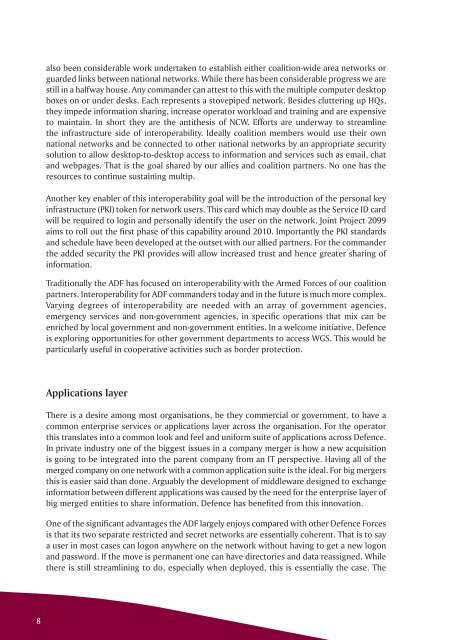ISSUE 176 : Jul/Aug - 2008 - Australian Defence Force Journal
ISSUE 176 : Jul/Aug - 2008 - Australian Defence Force Journal
ISSUE 176 : Jul/Aug - 2008 - Australian Defence Force Journal
Create successful ePaper yourself
Turn your PDF publications into a flip-book with our unique Google optimized e-Paper software.
also been considerable work undertaken to establish either coalition-wide area networks or<br />
guarded links between national networks. While there has been considerable progress we are<br />
still in a halfway house. Any commander can attest to this with the multiple computer desktop<br />
boxes on or under desks. Each represents a stovepiped network. Besides cluttering up HQs,<br />
they impede information sharing, increase operator workload and training and are expensive<br />
to maintain. In short they are the antithesis of NCW. Efforts are underway to streamline<br />
the infrastructure side of interoperability. Ideally coalition members would use their own<br />
national networks and be connected to other national networks by an appropriate security<br />
solution to allow desktop-to-desktop access to information and services such as email, chat<br />
and webpages. That is the goal shared by our allies and coalition partners. No one has the<br />
resources to continue sustaining multip.<br />
Another key enabler of this interoperability goal will be the introduction of the personal key<br />
infrastructure (PKI) token for network users. This card which may double as the Service ID card<br />
will be required to login and personally identify the user on the network. Joint Project 2099<br />
aims to roll out the first phase of this capability around 2010. Importantly the PKI standards<br />
and schedule have been developed at the outset with our allied partners. For the commander<br />
the added security the PKI provides will allow increased trust and hence greater sharing of<br />
information.<br />
Traditionally the ADF has focused on interoperability with the Armed <strong>Force</strong>s of our coalition<br />
partners. Interoperability for ADF commanders today and in the future is much more complex.<br />
Varying degrees of interoperability are needed with an array of government agencies,<br />
emergency services and non-government agencies, in specific operations that mix can be<br />
enriched by local government and non-government entities. In a welcome initiative, <strong>Defence</strong><br />
is exploring opportunities for other government departments to access WGS. This would be<br />
particularly useful in cooperative activities such as border protection.<br />
Applications layer<br />
There is a desire among most organisations, be they commercial or government, to have a<br />
common enterprise services or applications layer across the organisation. For the operator<br />
this translates into a common look and feel and uniform suite of applications across <strong>Defence</strong>.<br />
In private industry one of the biggest issues in a company merger is how a new acquisition<br />
is going to be integrated into the parent company from an IT perspective. Having all of the<br />
merged company on one network with a common application suite is the ideal. For big mergers<br />
this is easier said than done. Arguably the development of middleware designed to exchange<br />
information between different applications was caused by the need for the enterprise layer of<br />
big merged entities to share information. <strong>Defence</strong> has benefited from this innovation.<br />
One of the significant advantages the ADF largely enjoys compared with other <strong>Defence</strong> <strong>Force</strong>s<br />
is that its two separate restricted and secret networks are essentially coherent. That is to say<br />
a user in most cases can logon anywhere on the network without having to get a new logon<br />
and password. If the move is permanent one can have directories and data reassigned. While<br />
there is still streamlining to do, especially when deployed, this is essentially the case. The<br />
8

















